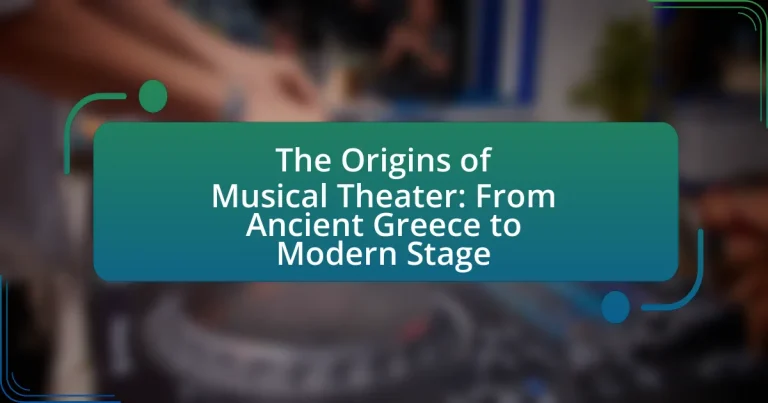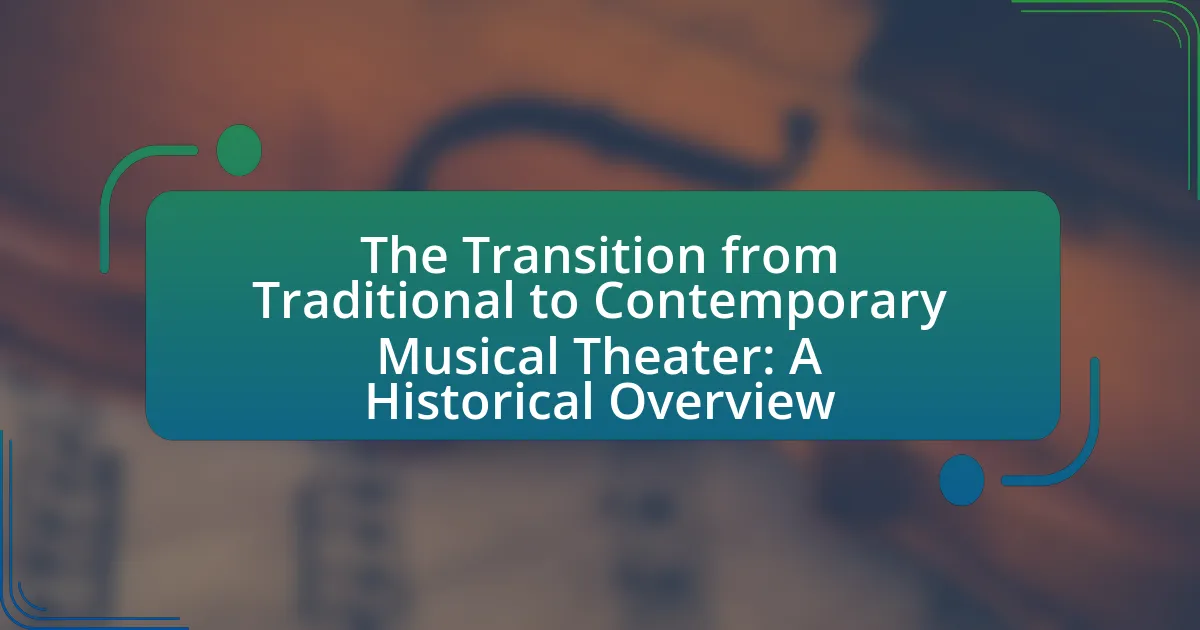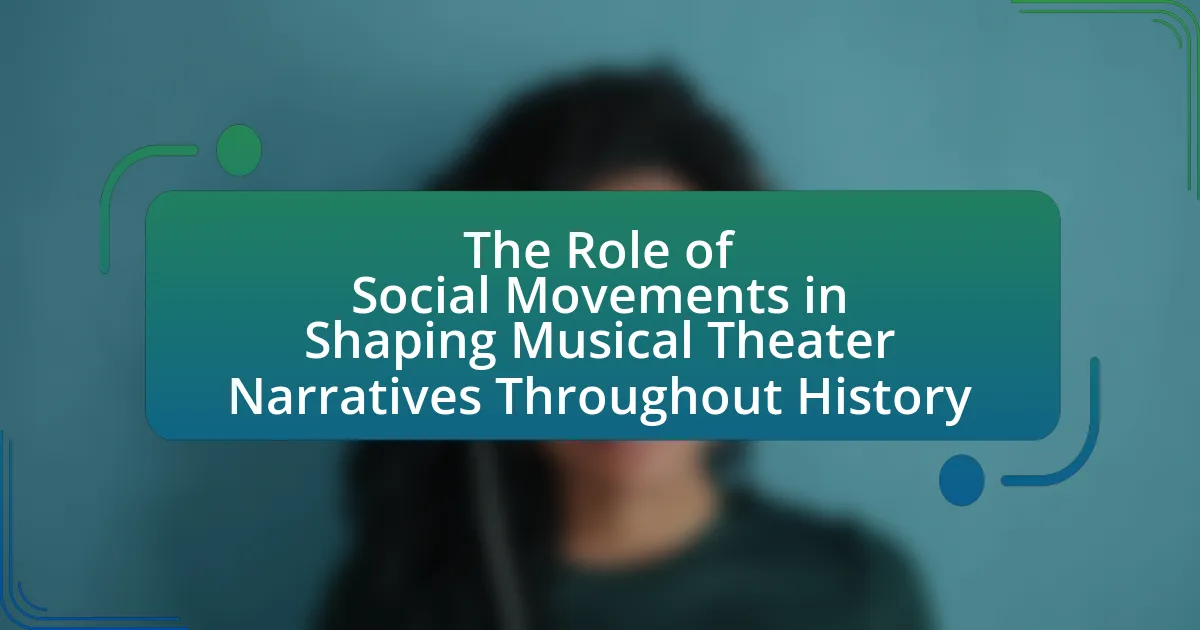The article explores the historical roots of musical theater, tracing its evolution from ancient Greek theater, where music, dance, and drama were integrated, to the modern stage. It highlights the influence of various cultures, including Roman, Asian, and Renaissance traditions, on the development of musical forms. Key developments such as the emergence of opera, operettas, and the rise of vaudeville in the 19th century are discussed, along with the defining features of contemporary musicals that reflect complex narratives and diverse musical styles. The article also examines the impact of cultural and social movements, technological advancements, and practical tips for engaging with musical theater today.

What are the Historical Roots of Musical Theater?
The historical roots of musical theater can be traced back to ancient Greek theater, where performances combined music, dance, and drama. In ancient Greece, plays often featured choruses that sang and danced, integrating musical elements into storytelling. This tradition evolved through the Roman era, where theatrical performances included music and spectacle, influencing later European forms. The Renaissance period saw the emergence of opera in Italy, which further blended music and drama, laying the groundwork for modern musical theater. By the 19th century, the development of operettas and vaudeville in Europe and America introduced more accessible musical forms, ultimately leading to the establishment of the contemporary musical theater genre.
How did Ancient Greece influence the development of musical theater?
Ancient Greece significantly influenced the development of musical theater through its integration of music, dance, and drama in theatrical performances. The Greek theater, particularly during the festivals honoring Dionysus, featured plays that combined spoken dialogue with choral music and dance, establishing a foundational structure for modern musical theater. Notably, playwrights like Aeschylus, Sophocles, and Euripides incorporated music into their works, which emphasized emotional expression and storytelling. This blend of artistic elements laid the groundwork for the musical format, where narrative and performance are intertwined, a hallmark of contemporary musical theater.
What role did Greek tragedies and comedies play in early musical forms?
Greek tragedies and comedies significantly influenced early musical forms by integrating music and performance to enhance storytelling. In ancient Greece, these theatrical genres utilized choral music and lyrical poetry, which were essential components of the performances, creating a foundation for the musical elements in theater. The use of music in tragedies, such as those by Aeschylus and Sophocles, and comedies, like those by Aristophanes, established a precedent for the emotional and narrative depth that music could provide in theatrical contexts. This integration of music and drama laid the groundwork for the development of musical theater, demonstrating how early forms of performance art combined various elements to engage audiences and convey complex themes.
How did music and performance intertwine in Ancient Greek culture?
Music and performance were deeply intertwined in Ancient Greek culture, as they were essential components of theatrical productions and religious ceremonies. The Greeks utilized music to enhance the emotional impact of performances, particularly in tragedies and comedies, where choruses sang and danced to convey themes and narratives. Historical evidence shows that playwrights like Aeschylus and Sophocles incorporated musical elements into their works, with the chorus often serving as a musical commentary on the action. Additionally, festivals such as the Dionysia celebrated the god Dionysus with dramatic performances that included music, illustrating the cultural significance of this integration.
What other ancient cultures contributed to the evolution of musical theater?
Ancient cultures such as Egypt, India, and China significantly contributed to the evolution of musical theater. In ancient Egypt, theatrical performances often included music and dance as part of religious rituals and celebrations, exemplified by the Opet Festival, which featured dramatic reenactments. Indian classical theater, particularly through forms like Kathakali and Natyashastra, integrated music, dance, and storytelling, influencing the narrative structure of musical theater. Additionally, ancient Chinese theater, with its rich tradition of opera, combined music, acrobatics, and drama, laying foundational elements for musical storytelling. These cultures collectively enriched the theatrical landscape, shaping the development of musical theater as it is known today.
How did Roman theater adapt Greek traditions?
Roman theater adapted Greek traditions by incorporating elements such as the use of masks, theatrical structures, and performance styles while also introducing new genres and themes. The Romans maintained the Greek practice of using masks to convey emotions and character traits, but they also developed more elaborate stage designs, including the use of the scaenae frons, a richly decorated backdrop. Additionally, Roman theater expanded the repertoire by introducing comedic forms like the Atellan farce and incorporating local cultural elements, which led to a distinct theatrical identity. This adaptation is evident in the works of playwrights like Plautus and Terence, who drew inspiration from Greek comedies while infusing them with Roman societal themes and humor.
What influences did Asian theatrical traditions have on musical theater?
Asian theatrical traditions have significantly influenced musical theater through their unique storytelling techniques, performance styles, and musical elements. For instance, the use of stylized movement and elaborate costumes in traditional Asian performances, such as Chinese opera and Japanese Noh theater, has inspired the visual aesthetics of modern musical theater. Additionally, the integration of music and dance as essential components of storytelling in Asian theater has shaped the narrative structure of musicals, emphasizing emotional expression and character development. Historical examples include the incorporation of Asian musical scales and instruments, which have enriched the soundscapes of contemporary productions. The cross-cultural exchange, particularly during the 20th century, further solidified these influences, as seen in works like “The King and I,” which blends Western musical forms with Eastern themes and motifs.
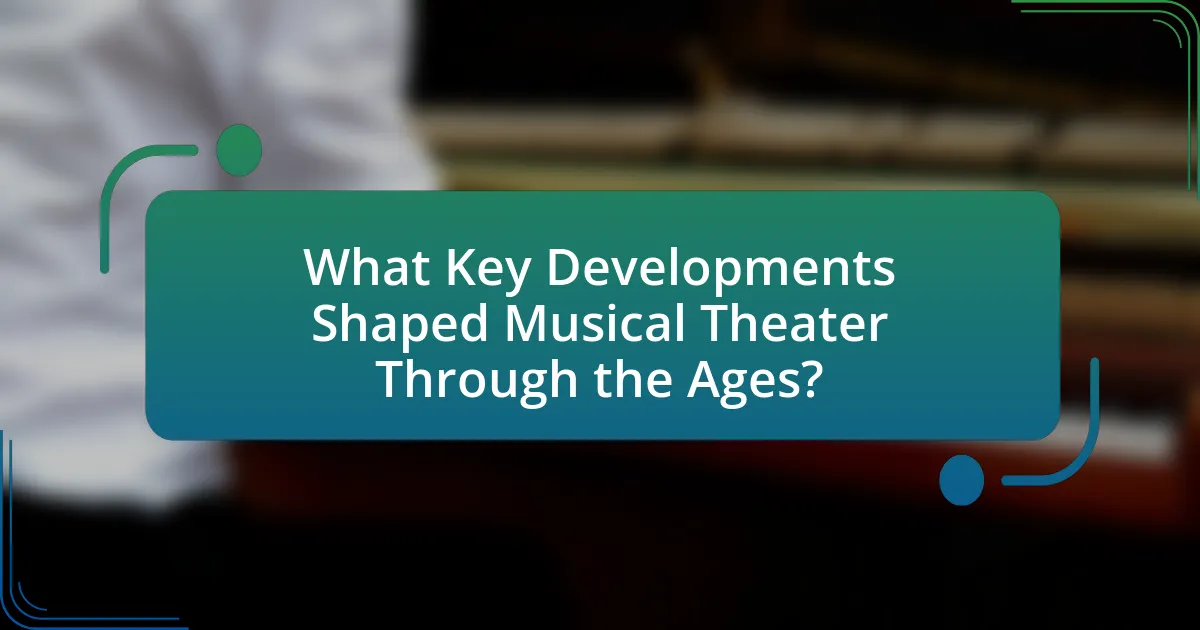
What Key Developments Shaped Musical Theater Through the Ages?
Key developments that shaped musical theater through the ages include the integration of music and drama in ancient Greek theater, the emergence of opera in the 16th century, the rise of the musical comedy in the 19th century, and the evolution of the modern musical in the 20th century. Ancient Greek theater utilized music and performance to enhance storytelling, laying the groundwork for future forms. The invention of opera introduced a structured format combining singing and orchestration, influencing subsequent theatrical productions. The 19th century saw the birth of musical comedy, which blended humor with song and dance, making theater more accessible. Finally, the modern musical, characterized by complex narratives and diverse musical styles, emerged in the 20th century, reflecting societal changes and innovations in stagecraft. Each of these developments contributed significantly to the evolution of musical theater as a dynamic art form.
How did the Renaissance revive interest in musical performance?
The Renaissance revived interest in musical performance by reintroducing classical ideals and fostering a culture of artistic expression. This period saw the emergence of humanism, which emphasized the value of individual creativity and the study of ancient texts, leading to a renewed focus on music as a vital form of art. Composers like Josquin des Prez and Giovanni Pierluigi da Palestrina advanced polyphonic techniques, while the invention of the printing press in the 15th century facilitated the distribution of musical scores, making music more accessible. Additionally, the rise of secular themes in music and the establishment of public performances contributed to a vibrant musical culture, reflecting the era’s broader artistic revival.
What were the characteristics of early operas during the Renaissance?
Early operas during the Renaissance were characterized by a blend of music, drama, and elaborate staging, emphasizing emotional expression and storytelling. These operas often featured a clear distinction between recitative, which advanced the plot, and arias, which allowed for emotional reflection. The use of mythological and historical themes was prevalent, drawing inspiration from classical antiquity. Additionally, early operas incorporated instrumental music, with orchestras playing a significant role in enhancing the narrative. The first known opera, “Dafne,” composed by Jacopo Peri in 1597, exemplifies these characteristics by combining sung dialogue with instrumental accompaniment, setting the foundation for the genre’s development.
How did the emergence of commedia dell’arte influence musical theater?
The emergence of commedia dell’arte significantly influenced musical theater by introducing improvisation, stock characters, and a focus on physical comedy. This Italian theatrical form, which gained popularity in the 16th century, emphasized spontaneous performances and character archetypes, such as Harlequin and Pantalone, which later became integral to musical theater’s character development. The incorporation of music and dance in commedia dell’arte performances laid the groundwork for the musical elements that define modern musical theater, as seen in works like “The Threepenny Opera” and “West Side Story.” The blending of scripted dialogue with musical interludes in these productions reflects the improvisational spirit and character-driven narratives that originated from commedia dell’arte.
What impact did the 19th century have on the evolution of musical theater?
The 19th century significantly transformed musical theater by introducing new forms, styles, and production techniques. This period saw the emergence of operettas and the development of the modern musical, characterized by a blend of spoken dialogue and song. Notable works, such as Gilbert and Sullivan’s “The Mikado” (1885), showcased this evolution, combining humor with social commentary. Additionally, the rise of vaudeville and variety shows expanded the audience and accessibility of musical performances, leading to a broader cultural impact. The establishment of Broadway as a theatrical hub in the late 19th century further solidified the importance of musical theater in American culture, setting the stage for future innovations in the genre.
How did the rise of vaudeville and operetta shape modern musical forms?
The rise of vaudeville and operetta significantly shaped modern musical forms by introducing a blend of diverse entertainment styles and emphasizing narrative through song and dance. Vaudeville, characterized by its variety acts, showcased a range of performances including comedy, music, and dance, which influenced the structure and pacing of contemporary musicals. Operetta, with its light opera format, integrated spoken dialogue with musical numbers, establishing a precedent for the book musical format that dominates today. The combination of these elements fostered a more cohesive storytelling approach in musicals, allowing for emotional depth and character development, as seen in works like “West Side Story” and “Hamilton.” This evolution reflects the foundational impact of vaudeville and operetta on the modern musical landscape.
What role did technological advancements play in musical theater during this period?
Technological advancements significantly enhanced musical theater by improving production quality and audience engagement. Innovations such as electric lighting, introduced in the late 19th century, allowed for more dynamic stage effects and mood settings, transforming the visual experience of performances. Additionally, advancements in sound technology, including the introduction of microphones and sound amplification, enabled clearer vocal performances, making it possible for larger audiences to enjoy the music without distortion. These developments not only elevated the artistic expression within musical theater but also expanded its accessibility, allowing for larger venues and broader audiences, thus contributing to the genre’s growth and popularity during this period.
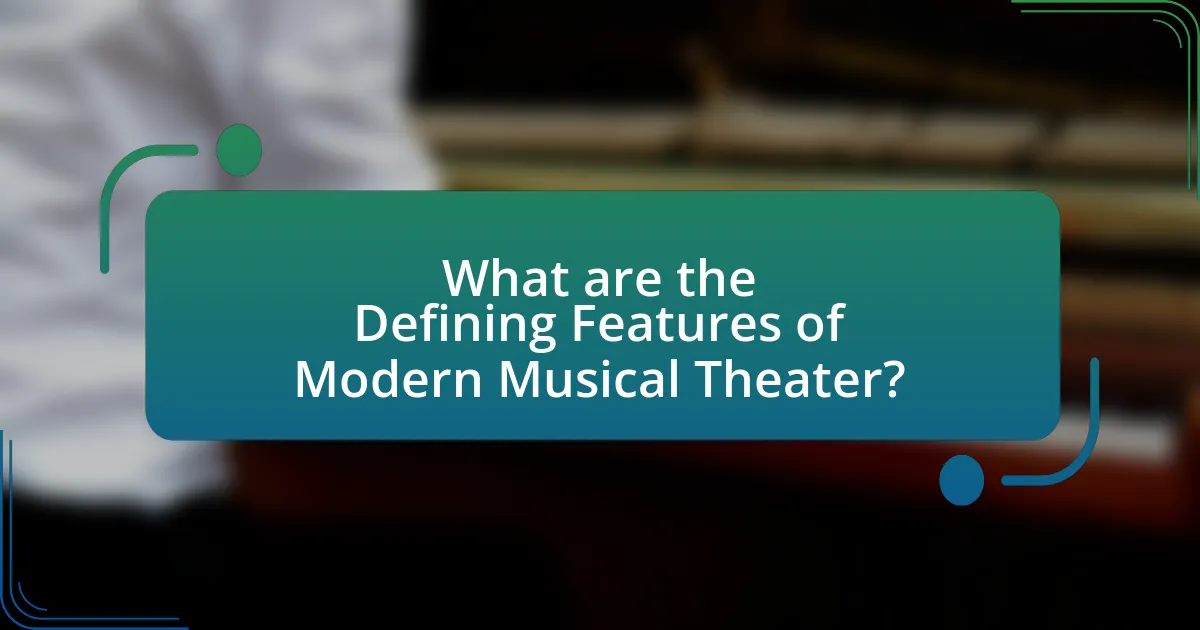
What are the Defining Features of Modern Musical Theater?
Modern musical theater is characterized by its integration of diverse musical styles, complex narratives, and strong character development. This genre often blends elements of pop, rock, and hip-hop with traditional show tunes, reflecting contemporary musical trends. Additionally, modern musicals frequently address social issues and personal themes, making them relevant to today’s audiences. Notable examples include “Hamilton,” which uses hip-hop to tell the story of America’s founding fathers, and “Dear Evan Hansen,” which explores mental health and social anxiety. These features demonstrate how modern musical theater evolves by incorporating current cultural contexts and innovative storytelling techniques.
How do contemporary musicals differ from their historical predecessors?
Contemporary musicals differ from their historical predecessors primarily in their thematic complexity and musical diversity. While historical musicals often focused on straightforward narratives and traditional musical styles, contemporary works frequently explore complex social issues, diverse cultural influences, and innovative musical genres, such as hip-hop and rock. For example, Lin-Manuel Miranda’s “Hamilton” integrates hip-hop to tell the story of America’s founding, reflecting modern storytelling techniques and cultural relevance. This evolution showcases a shift towards inclusivity and experimentation in both narrative and musical composition, marking a significant departure from the more formulaic approaches of earlier musicals.
What are the key elements that define a modern musical?
The key elements that define a modern musical include a strong narrative structure, character development, integration of song and dance, contemporary themes, and diverse musical styles. A strong narrative structure ensures that the story is engaging and cohesive, while character development allows audiences to connect emotionally with the characters. The integration of song and dance is essential, as it enhances storytelling and adds emotional depth. Contemporary themes reflect current societal issues, making the musical relevant to modern audiences. Additionally, diverse musical styles, ranging from pop to hip-hop, showcase the evolution of musical theater and appeal to a broader audience. These elements collectively contribute to the unique identity of modern musicals, distinguishing them from traditional forms of theater.
How has storytelling evolved in modern musical theater?
Storytelling in modern musical theater has evolved to incorporate complex narratives, diverse perspectives, and innovative structures. Unlike traditional musicals that often relied on linear plots and archetypal characters, contemporary works frequently explore themes of identity, social issues, and emotional depth, as seen in productions like “Hamilton,” which blends historical narrative with modern musical styles. This evolution is supported by the increasing use of non-linear storytelling techniques and multimedia elements, allowing for a richer, more immersive experience that reflects the complexities of modern life.
What are the major influences on today’s musical theater landscape?
The major influences on today’s musical theater landscape include cultural diversity, technological advancements, and the impact of social issues. Cultural diversity has enriched musical theater by incorporating various musical styles and narratives from different cultures, leading to productions like “Hamilton,” which blends hip-hop with traditional musical elements. Technological advancements, such as improved sound design and digital effects, have transformed staging and audience engagement, exemplified by shows like “Dear Evan Hansen.” Additionally, the focus on social issues, including race, gender, and mental health, has shaped contemporary narratives, as seen in productions like “The Prom,” which addresses LGBTQ+ themes. These influences collectively reflect the evolving nature of musical theater, making it more inclusive and relevant to modern audiences.
How do cultural and social movements impact musical theater themes?
Cultural and social movements significantly shape musical theater themes by reflecting societal values, struggles, and aspirations. For instance, the civil rights movement in the 1960s inspired works like “Hair” and “Porgy and Bess,” which addressed issues of race and identity. Additionally, the feminist movement influenced musicals such as “The Color Purple,” highlighting women’s experiences and empowerment. These movements not only provide content for narratives but also influence the style, music, and presentation of the theater, making it a dynamic medium that evolves with societal changes.
What role does technology play in the production of modern musicals?
Technology plays a crucial role in the production of modern musicals by enhancing storytelling, improving stagecraft, and facilitating audience engagement. Advanced sound systems allow for clearer audio, enabling performers’ voices to reach audiences effectively, while sophisticated lighting technology creates dynamic atmospheres that complement the narrative. Additionally, digital projections and multimedia elements enrich visual storytelling, providing immersive experiences that were not possible in earlier theatrical forms. For instance, the use of automated stage machinery allows for seamless scene changes, which enhances the flow of the performance. These technological advancements have transformed the landscape of musical theater, making it more accessible and engaging for contemporary audiences.
What are some practical tips for engaging with musical theater today?
To engage with musical theater today, attend live performances, participate in community theater, and explore digital platforms offering streaming options. Attending live performances allows individuals to experience the energy and artistry of the stage firsthand, while community theater provides opportunities for involvement in productions, fostering a deeper appreciation for the craft. Additionally, streaming platforms like BroadwayHD and Disney+ offer access to recorded performances, making it easier to discover and enjoy a variety of shows from home. These methods enhance understanding and enjoyment of musical theater, reflecting its evolution from ancient traditions to contemporary expressions.
How can audiences appreciate the nuances of musical theater performances?
Audiences can appreciate the nuances of musical theater performances by actively engaging with the storytelling, character development, and musical composition. Understanding the historical context of musical theater, which dates back to ancient Greece, enhances appreciation as it reveals how themes and styles have evolved. For instance, recognizing the influence of Greek tragedies on modern musicals allows audiences to see parallels in emotional depth and narrative structure. Additionally, paying attention to the subtleties in actors’ performances, such as facial expressions and vocal inflections, can deepen the emotional connection to the characters and story. Engaging with the lyrics and their meanings also enriches the experience, as many songs convey critical plot points or character emotions. Overall, a combination of historical knowledge and active observation fosters a greater appreciation for the complexities of musical theater.
What are the best practices for aspiring musical theater performers?
Aspiring musical theater performers should focus on developing strong vocal, acting, and dance skills. These three disciplines are essential, as successful performances require a blend of singing, acting, and movement. Regular training in each area enhances versatility and marketability in the competitive field of musical theater.
Additionally, participating in workshops and auditions helps performers gain practical experience and exposure. Networking within the industry is crucial, as connections can lead to opportunities. Engaging with a variety of musical theater styles, from classical to contemporary, broadens a performer’s repertoire and adaptability.
Moreover, studying the history and evolution of musical theater, from its origins in ancient Greece to modern interpretations, provides valuable context that can inform a performer’s approach and interpretation of roles. This knowledge can enhance performance authenticity and depth.
